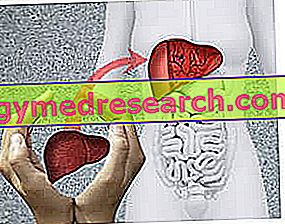Generality
The endometriosic cyst, also known as endometrioma, is a pathological ovarian cyst, which appears due to endometriosis.
Endometriotic cysts are pockets filled with "old" blood, of endometrial origin; normally, they measure between 2 and 5 centimeters in diameter, but, in some rare circumstances, they can even reach 10-20 centimeters.

The rupture of an endometrioma - a condition that, in the medical field, is considered an emergency - is responsible for: severe pelvic pain, blood loss from the vagina, fever, nausea and vomiting.
The treatment can be pharmacological or surgical, depending on how severe the endometriotic cyst is present: in general, small cysts require drug therapy, while large cysts make surgery indispensable.
A brief review of what ovarian cysts are
Ovarian cysts are pockets filled with liquid or solid material, which can form on or inside a woman's ovaries . In most cases, they are something physiological, which depends on the menstrual cycle ; more rarely, they are the consequence of benign or malignant tumors, or of pathological conditions such as endometriosis or polycystic ovary .
In the medical field, physiological ovarian cysts are called functional cysts, while ovarian cysts due to a pathological condition are called pathological (or non-functional) cysts .
What is an endometriotic cyst?
The endometriosic cyst, or endometrioma, is a pathological ovarian cyst that appears in the presence of endometriosis .
WHAT IS ENDOMETRIOSIS?
Briefly, endometriosis is a disease characterized by the presence of endometrial tissue outside its natural site, which is the uterus .
In the presence of endometriosis, therefore, endometrial tissue can be found in the thickness of the myometrium (NB: it is part of the uterus, but it is not the natural site of the endometrial tissue), in the ovaries, between the rectum and the uterus, between the rectum and the vagina, on the Fallopian tubes, on the bladder, on the ureter and / or on the sigma portion of the colon.
It mainly affects women of childbearing age and is generally responsible for: chronic pelvic pain, dysmenorrhea, pain during sexual intercourse, dyspareunia, diarrhea and vaginal bleeding.
Despite numerous studies on the subject, the precise causes of endometriosis and the consequences that this condition can have on women's fertility remain a mystery for now.
In mild forms of endometriosis, doctors advise waiting for the disease to evolve in the future 6-12 months, as spontaneous healing may occur. In the presence of severe forms, instead, they recommend a pharmacological or surgical therapy (conservative or demolitiva surgery).
The choice between drug therapy and surgical therapy depends on the severity of the disease, the desire for pregnancy and the age of the woman.
CHARACTERISTICS OF THE ENDOMETRIOSIC CYST
The endometriosic cyst is filled with a thick chocolate-brown liquid . This liquid is mostly "old" blood, coming from the endometrial tissue located outside its natural site.
In general, endometriomas measure between 2 and 5 centimeters in diameter; however, in some rare circumstances, they can even reach 10-20 centimeters.
They are not malignant tumors, but in very remote cases (less than 1%) it is possible that they give rise to malignant neoplasms.
Due to their chocolate color content, endometriomas are also called " chocolate cysts ".
IS IT ALWAYS AND ONLY AN OVARIAN CYST?
It is inappropriate to refer to an endometriotic cyst as being exclusively an ovarian cyst.
In fact, endometriotic cysts can form not only on the ovaries, but also on the fallopian tubes, on portions of the intestine (rectum or sigma) or on portions of peritoneum.
It is usually referred to as ovarian cysts, as the ovaries are the organs involved in most cases (about 75% of episodes of endometriotic cysts involve the ovary).
Epidemiology
Episodes of endometriotic cysts generally affect women of childbearing age, between 30 and 40 years.
According to some statistical research, 5-10% of the female population would be subject to endometrioma.
For unknown reasons, most endometriotic cysts occur in the left ovary.
Causes
Although doctors have investigated them for a long time and are still researching them, the precise causes of endometriotic cysts remain a mystery.
AN IMPORTANT OBSERVATION
During their studies on the possible causes of endometriosic cysts, doctors and scientists observed that hormonal changes, which characterize a woman's menstrual cycle, tend to worsen the extent of endometriomas. All this led them to think that there may be a connection between the menstrual cycle and the formation of endometriotic cysts.
Symptoms
The typical symptoms of an intact endometriotic cyst are:
- Cramps in the lower abdomen;
- Significantly painful menstruation (dysmenorrhea);
- Pelvic pain, during urination or during defecation;
- Pelvic pain, during physical activity and body movements in general.
WHAT HAPPENS IF THE CYST ENDOMETRIOSIC BREAKS?
An endometriotic cyst can rupture.
The rupture of an endometrioma represents a clinical condition of significant importance.
Its typical symptoms are:
- Strong pain in the abdomen;
- Fever, vomiting and nausea;
- Vaginal bleeding, which involves the release of a characteristic dark blood.
WHAT TO DO IN CASE OF BREAKAGE?
The rupture of an endometriotic cyst is a medical emergency, for which it is best to contact your doctor immediately or contact the nearest hospital.
ENDOMETRIOSIC CYST AND INFERTILITY
Scientific studies have shown that the endometriosic cyst does not compromise the quality of the egg cell, but rather interferes with the development of the follicle and with the ovulation process (NB: ovulation is the escape of the mature egg cell from the follicle, towards the fallopian tubes).
Failure to carry out the correct ovulation process means that the meeting between the mature egg cell and the spermatozoon is unlikely or, alternatively, very dangerous. The danger that lies behind such a situation is the risk of an ectopic pregnancy .
Diagnosis
In general, the diagnostic procedure to which women suspected of suffering from endometriotic cysts are subjected includes:
- A careful objective examination;
- An accurate medical history;
- Pelvic ultrasound and / or transvaginal ultrasound;
- A nuclear magnetic resonance and / or a CT scan
Ultrasounds, nuclear magnetic resonance and CT scans serve, above all, to understand the severity of the endometriosic cyst.
Therapy
The treatment of an endometriosic cyst depends on the symptoms it causes and on its severity, detected through diagnostic tests.
If the endometriosic cyst is the cause of a mild symptomatology and the diagnostic tests appear not serious, the doctors opt for a pharmacological treatment ; on the contrary, if the endometrioma is responsible for severe symptoms and diagnostic tests appear as a serious condition, they choose for surgical treatment .
In general, however, drug treatment is the first line therapy, while surgery is the therapy adopted in cases where drugs are ineffective.
PHARMACOLOGICAL TREATMENT
Pharmacological treatment for endometriotic cysts is similar to drug treatment for endometriosis. Thus, it includes:
- Non-steroidal anti-inflammatory drugs (so-called NSAIDs);
- Gonadotropin-releasing hormone analogues, to suppress estrogen production;
- Androgenic hormone derivatives, which reduce the levels of estrogen and progesterone, inducing as an effect the atrophy of the abnormal endometrial tissue;
- Contraceptive pill, to reduce the levels of those hormones that promote the growth of endometrial tissue;
- Aromatase inhibitors, to reduce estrogen production;
- Progesterone derivatives, to induce atrophy of abnormal endometrial tissues.
SURGICAL TREATMENT
For women of childbearing age, surgical treatment generally consists of the removal of the only endometriotic cyst ( ovarian cystectomy ). This is a delicate operation, but fundamental in order not to preclude any future pregnancy for the patient.
- Damage to the ovaries
- Endometriotic cyst rupture, during surgery
- Infertility
- Ache
- hemorrhage
- Infections
For women who have passed menopause, on the other hand, surgical treatment usually involves removing the entire ovary with an endometriotic cyst ( ovariectomy ). This solution is more successful than ovarian cystectomy and is safer, but it is not recommended for young women, because it greatly reduces the chances of pregnancy.
According to some statistical studies, the success of endometriotic cyst surgery increases the possibility of having children by a woman of childbearing age by 50%.
Prognosis
The prognosis varies from patient to patient, depending on the size and precise location of the endometriotic cyst present.
In essence, this means that a large-sized endometriotic cyst, and / or located in surgically uncomfortable areas to reach, will have a more unfavorable prognosis than a small-medium sized and / or comfortable endometriotic cyst to be removed.



